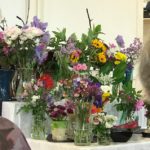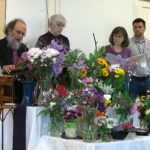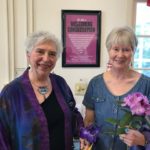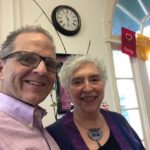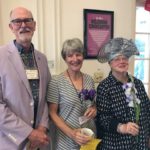Harrisonburg Unitarian Universalist Flower Communion
May 5, 2019
Facilitator: Martha Sider
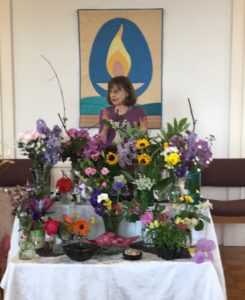
2019 Flower Communion
The title of today’s service is taken from the song “ White Coral Bells†You’ll find it printed on the insert to the OOS. White coral bells upon a slender stalk, Lilies of the Valley deck my garden walk… I, like many children, was introduced to this song at summer camp, Kenbrook Bible Camp. And yes, at that camp we sang mainly specifically Christian songs around the campfire, but this song I learned with a group of girls in the cabin with our counselor at lights out time. We sang it as a round, our little girl voices joined together, and I loved being a part of that community. Many years later, the Lilies of the Valley in my garden today are a gift of this community shared from Cathy and Charlie’s garden.
Lilies of the Valley hold much significance around the world – they are said to bring luck, used in weddings to symbolize purity, in Christian lore (mentioned 15 times in the Bible) used to symbolize tears (Eve’s, the Virgin Mary’s, Mary Magdalene’s at the cross of Jesus) and in some folklore they are believed to protect from evil spirits, charm against witches spells and considered the flowers of the fairies, their tiny bells used as cups from which to drink. Some in European countries hold the belief that Lilies of the Valley prompt visions of heaven.
However, aside from folklore, I think these beautiful, sweetly scented flowers call us to an awareness of our HUU community.
- Lilies of the Valley form extensive colonies by spreading underground. New shoots are formed at the ends of stolons, but they stay connected to the other shoots underground.
- They are complex, holding together in one stalk the poisonous and the healing.
- They are strong, returning year after year, pushing through the darkness, the layers of earth and the mulch that may have been heaped upon them.
- They are also delicate, susceptible to the stress of high temperatures and in need of the sheltering shade of other garden plants.
We are the lilies of the Shenandoah Valley, white coral bells. “Oh, don’t you wish that you could hear them ring? That will happen only when the fairies sing.†In this religious community where as we often sing “we seek elusive answers to the questions of this life†and can claim that “even to question, truly is an answer,†that will happen only when we open ourselves to the experience of transcending wonder and mystery.
Today our four readers will offer words that hopefully inspire us to seek the “direct experience of that transcending mystery and wonder” stated as one of the many sources from which we draw.
Following each reading Dee will key us in and together we’ll sing our response, “White Coral Bells.â€
Readings and Choral Response
Leader: Listen to the words of A. Powell Davies:
Reader 1: There is no mystery greater than our own mystery. We are, to ourselves, unknown. And yet we do know. The thought we cannot quite think is nevertheless somehow a thought, and it lives in us without our being able to think it. We are a mystery, but we are a living mystery. The most alive thing about us is what we are when thought breaks off and our mind can go no further — for that is where our yearning begins, our inconsolable yearning, and the loneliness that begets compassion, the forlornness that prepares the heart for love.
Choral Response:
White coral bells upon a slender stalk
Lilies of the Valley deck my garden walk
Oh, don’t you wish that you could hear them ring?
That will happen only when the fairies sing.
Leader: Listen to the words of Carrie Newcomer:
Reader 2: Wendell Berry describes the presence of mystery in the world as “a bird that calls and waits and calls again.†There is an ever-present wholeness that is always resting quietly beneath the clamor. This presence is so faithful that we stop noticing it, in the same way we stop noticing the air we breathe until the wind swifts and the trees lean over in a new direction. What a gift it is to rise from our thoughts and the busy world and sense that ever present wholeness.
Today is a good day to practice listening for the quietest thing that moves through the most quiet houses. It is a good day to notice on a busy street that the people around us are tender and funny, strong and luminous as the sun. Today is a good day to breathe and listen for the bird that calls, pauses, and calls again.
Choral Response
Leader: Listen to the words of Richard Rohr
Reader 3: Once I can see the Mystery here, and trust the Mystery even in this piece of clay that I am, then I can also see it in you. We are eventually able to see the divine image within ourselves, in each other, and in all things. Finally, the seeing is one. How you see anything is how you will see everything.
Choral Response
Leader: Listen to the words of Howard Thurman:
Reader 4: The humble spirit: I learn the meaning of the humble spirit from the earth. The earth takes into itself the rain, the heat of the sun, and it works with these gifts of life to bring the magic out of itself to be used for growth and sustenance of all living things. The earth is good because it takes what life gives, and within itself it uses its gifts to make life abound. It waits for fruition and gathers its fruit unto itself for more life and more growing. I shall learn of the earth the meaning of the humble spirit.
Choral Response
Leader: Listen to the words of Walt Whitman
Reader 1: Why, who makes much of a miracle?
As to me I know of nothing else but miracles,
Whether I walk the streets of Manhattan,
Or dart my sight over the roofs of houses toward the sky,
Or wade with naked feet along the beach just in the edge of the water,
Or stand under trees in the woods,
Or talk by day with any one I love, or sleep in the bed at
night with any one I love,
Or sit at table at dinner with the rest,
Or look at strangers opposite me riding in the car,
Or watch honey-bees busy around the hive of a summer forenoon,
Or animals feeding in the fields,
Or birds, or the wonderfulness of insects in the air,
Or the wonderfulness of the sundown, or of stars shining so quiet and bright,
Or the exquisite delicate thin curve of the new moon in spring;
These with the rest, one and all, are to me miracles,
The whole referring, yet each distinct and in its place.
Choral Response
Leader: Listen to the words of Eric Banner:
Reader 2: Personally, I don’t think you need to be fearful to at least hold onto the recognition that there are things that are mysteries to be solved and there are things that are mysteries to simply stand before in fascination. It’s not the only way to be religious, but it’s one of them that helps orient us with humility. So whether you find the core of your religious identity in shared text, or an experience of awe, the regular use of reason in search of truth, or in the practiced rituals of weekly life, I hope that you know who you are, and where you fit in this mysterious universe we call home.
Choral Response
Leader: Listen to the words of Wislawa Szymborska:
Reader 3: The world – whatever we might think when terrified by its vastness and our own impotence, or embittered by its indifference to individual suffering, of people, animals, and perhaps even plants, for why are we so sure that plants feel no pain; whatever we might think of its expanses pierced by the rays of stars surrounded by planets we’ve just begun to discover, planets already dead? still dead? we just don’t know; whatever we might think of this measureless theater to which we’ve got reserved tickets, but tickets whose lifespan is laughably short, bounded as it is by two arbitrary dates; whatever else we might think of this world – it is astonishing.
Choral Response
Leader: Listen to the words of Carrie Newcomer:
Reader 4: I am learning to sit with not knowing.
Even when my restless mind begins jumping
From a worried
What next,
To a frightened
What if,
To a hard edged and impatient,
Why aren’t you already there?I’m learning to sit and listen
To pat myself on the knee,
Lay my hand on my heart,
Take another deep breath,
Laugh at myself,
Befriend my mistakes,
Especially the ones,
That show me how,
I most need to change.I’m learning to sit with whatever comes
Even though I’m a hopeless planner,
Because so much of this life
Can’t be measured or predicted
Or evenly portioned.
Because wonder and suffering visit
When we least expect
And rarely In equal measure.I’m learning to sit with what
I might never know
Might never learn
Might never heal
With what might waltz in and surprise me
Might nudge me into the risky business of growing
Might crash into my days
With unspeakable sorrow
Or uncontainable delight.I’m learning to sit
With not knowing.
Choral response
Leader: Listen to the words of Henry Wadsworth Longfellow:
Reader 1: I heard the first wave of the rising tide
Rush onward with uninterrupted sweep;
A voice out of the silence of the deep,
A sound mysteriously multiplied
As of a cataract from the mountain’s side,
Or roar of winds upon a wooded steep.
So comes to us at times, from the unknown
And inaccessible solitudes of being,
The rushing of the sea-tides of the soul;
And inspirations, that we deem our own,
Are some divine foreshadowing and foreseeing
Of things beyond our reason or control.
Choral Response
Leader: Listen to the words of A. Powell Davies:
Reader 2: Life must have its sacred moments and holy places. We need the infinite, the limitless, the uttermost — all that can give the heart a deep and strengthening peace. We need religion with its faith and purpose; we need it as experience. We need the touch of beauty, bringing back to life its luster and its loveliness. We need the unutterable communion of our spirits with the spirit of the highest—all that joins the soul with what it yearns for, all that can raise the frailty of our incomplete humanity toward the level of the spirit’s aspirations—that our earthly dust may meet and mingle with the majesty and mystery of god.
Choral Response
Leader: Listen to the words of Mary Oliver:
Reader 3: Truly, we live with mysteries too marvelous
to be understood.How grass can be nourishing in the
mouths of the lambs.
How rivers and stones are foreverin allegiance with gravity
while we ourselves dream of rising.
How two hands touch and the bonds
will never be broken.
How people come, from delight or the
scars of damage,
to the comfort of a poem.Let me keep my distance, always, from those
who think they have the answers.Let me keep company always with those who say
“Look!†and laugh in astonishment, and bow their heads
Choral Response
Leader: Listen to the words of Carrie Newcomer:
Reader 4: When my daughter was four years old we went for a walk in a small local nature preserve. Half way up a switchback path that led to a wooded ridge top she stopped me and said, “Mommie listen.†I stopped and listened. I heard the rustling leaves and the wind moving through the autumn branches.
“What do you hear honey†I asked.
She looked at me with round frank eyes and said “angels are whispering.â€
I smiled with a motherly amusement and thought, “I really ought to write this down some where.†But then I watched her as she closed her eyes and nodded like a little Buddha. She took a deep breath and sighed. I remember wondering if it were possible that her younger ears might still be tuned into some higher frequency, still able to perceive subtle changes in air movement and pressure lost to adults. Could a four year old still let you know what’s coming or close, the way animals sometimes know there’s a storm coming before the first thunder grumbles in the distance? I wondered if there were really whisperings in the deep woods, poetry and murmurings between the spirits who abide in the natural places. Was there a presence that moves in and among all living growing things? Had my older ears lost their ability to hear at those frequencies, or had I just forgotten how to change channels from all my hurrying and working and wanting and winning and losing. I stopped. I closed my eyes and listened with my daughter’s ears. I did not know it at the time, but everything had just changed.
Choral Response
- Adam, Linda, Martha
